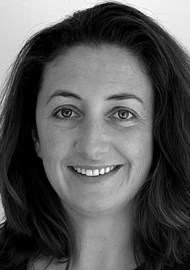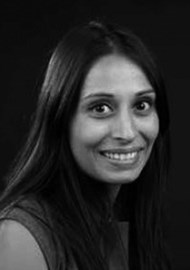
Miss Catherine Rennie has recently been recognised as one of the Women’s Engineering Society’s (WES) Top 50 Women in Engineering 2021. According to WES, these awards celebrate the “best, brightest and bravest women in engineering, who recognise a problem, then dare to be part of the solution”. The award recognised Miss Rennie’s work combining her expertise in ENT and aeronautical engineering. WENTS UK Consultant Representative, Nina Mistry, interviews Catherine Rennie to find out more regarding her research, how she manages to juggle all aspects of work and life and what drives her to keep pushing.
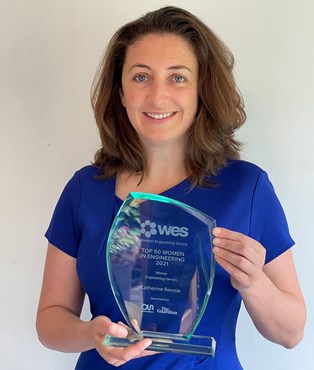
Catherine Rennie with her award.
What steps did you take to get where you are today?
I attended my local comprehensive school in Wales and then completed my medical degree at Imperial College School of Medicine. Towards the end of my undergraduate training, I knew that I wanted to pursue a career in surgery but didn’t know which specialty. As a result, I did SHO jobs in several surgical specialties (General surgery, orthopaedics, plastics, A&E) before spending six months in ENT which I loved, and I really liked the people working in it. That’s when I decided to pursue a career in ENT. As an SHO only just starting out in ENT, the Medical Training Application Service (MTAS) was introduced which then threw many people’s training into disarray. It was at this point that I took time out to do research. During my research I obtained my training number but deferred it to complete the research. Under the supervision of Professor Neil Tolley (Consultant Head and Neck Surgeon) and Professor Denis Doorly (from the Department of Aeronautics, Imperial College London) I undertook a project investigating nasal airflow and sinus ventilation. This involved collaboration between the departments of ENT, aeronautics and nuclear medicine. What started out initially as an MSc eventually turned into a PhD. I thoroughly enjoyed the research; I had a great team around me, and I have continued to participate as an honorary research fellow and lecturer on various projects since.
“I definitely find myself repeating some of her phrases to my trainees now and think ‘gosh, that sounded very Lund-like’!”
I completed my higher surgical training in London working at the Royal Free Hospital, Great Ormond Street Hospital, Charing Cross Hospital, the Royal Marsden and the Royal National Throat Nose and Ear Hospital, before undertaking a fellowship in rhinology and anterior skull base surgery at Imperial and was subsequently appointed as a consultant there.
What challenges have you faced and how have you overcome these challenges?
One of the first challenges was when MTAS was introduced. I’d been on a career path to get a training number and then the goal posts were suddenly changed. As I had already been successful in obtaining my MRCS and DOHNS exams, I was being told I had to decide on a specialty and commit to it. At this stage I had only done six months of ENT and was competing against others who had much more experience. It was at this stage that I investigated other opportunities that would improve my CV and help me in my application for a training number and this is why I looked at taking time out to do research. It was a difficult time and many doctors changed specialties and dropped out. I tried my best not to be knocked back and persevered to find a route through to obtaining a training number.
Research was also challenging to start with as, for the first six months, experiments weren’t working and I didn’t have any results. It was frustrating to go in daily and feel like I wasn’t progressing. However, I had a great team around me who encouraged me to keep going. I think having the courage to persist as well as looking at different ways around a problem really helped at this time.
Your role in the development of the ‘Zephyr Hood’ is ground-breaking - would you say that this has been your most exciting project to date?
Yes certainly, the Zephyr Hood is one of the projects that we have gone furthest with, and it has been exciting to work on this. Seeing it come through and be developed has been hugely rewarding. As ENT surgeons, we are aware of the risks associated with aerosol generation with COVID-19 and this had sadly been highlighted by the deaths of some ENT surgeons. At the start of the pandemic, I contacted Professor Doorly and Professor Tolley to see what we could do to make for a safer working space and prevent nosocomial infections with COVID-19. Professor Doorly put me in touch with Christian Fletcher, the Head of Concept Design at Mercedes AMG-Formula 1. This collaboration has resulted in the design of the Zephyr Hood which is an aerosol containment device. The other project which is also running with the same collaborators is the ‘Boreus shield’ which is an intraoperative aerosol containment device. This is in its testing phase.
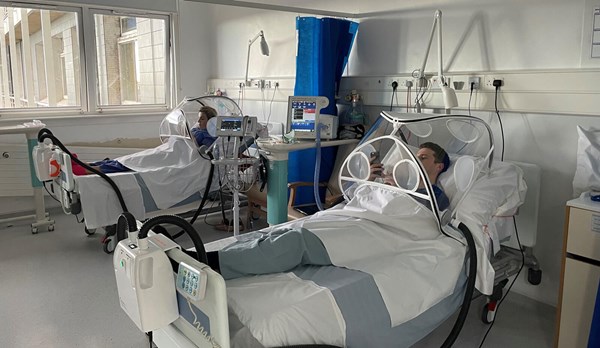
Together with colleagues and designers at Mercedes AMG-F1, Catherine helped develop
the Zephyr Hood to reduce the spread of aerosols in hospital wards.
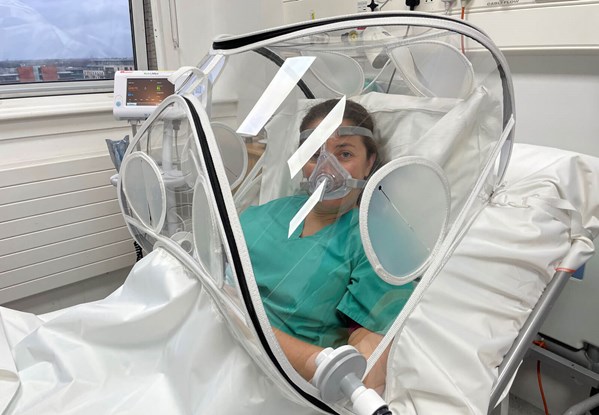
Catherine testing the Zephyr Hood.
“The other project which is also running with the same collaborators is the ‘Boreus shield’ which is an intraoperative aerosol containment device”
In addition, Professor David Howard invited me to join the Exovent team in Sept 2020. Exovent is charity led by a team of eminent anaesthetists, critical care doctors, paediatricians, surgeons, critical care nurses, senior engineers and commercial professionals. Exovent is developing modern negative pressure ventilators which have huge potential, not only in the COVID pandemic, but also for many respiratory diseases such as COPD and pneumonia. Mercedes AMG -F1 have also shown an interest in this with regards to developing a low-cost paediatric device for low- to middle-income countries.
All these projects are exciting and have certainly been keeping me busy!
How do you manage to fit in all of this research as well as your clinical work and having a life outside of the hospital?
It is definitely challenging to fit it all in, however, it is important to make time to go away and have time for yourself, friends and family. I was lucky that during the COVID-19 outbreak, I perhaps had more time to be able to do these projects which I wouldn’t have had normally. Due to the restrictions, I didn’t see my family for nearly a year, and I used this time to work instead. I do my best to keep weekends work-free wherever possible.
“Female mentors are great but having male allies who are prepared to put women forward is essential”
I think that being organised is the key to keeping on top of it all. I wish I was more organised! Virtual working has certainly made things easier to meet people and discuss things without the need to travel. The pandemic has also perhaps meant that people have more time, are keen to help and be involved and contribute to what they felt was a good cause. It all came at the right time. I don’t think I would have got a collaboration with Mercedes AMG-F1 had it not been for the pandemic.
Many see you as a role model - do you have a role model yourself?
I think that I have been very lucky throughout my training, and I have had some inspiring mentors and role models. In rhinology, I think we have been particularly fortunate in the UK and in Europe; for example, Professor Valerie Lund was one of my trainers and had a huge impact on me. I definitely find myself repeating some of her phrases to my trainees now and think ‘gosh, that sounded very Lund-like’! There are also Professor Wytske Fokkens, Professor Claire Hopkins and Professor Janet Wilson who have been great female role models. I have also had a strong network of male allies, who have really pushed me forward and encouraged me to pursue opportunities. Professor Hesham Saleh has been brilliant, encouraging me to speak on panels and putting me forward for things I wouldn’t have put myself forward for. This gives you the confidence to take that step. Equally, I could not have proceeded without the immense support of Professor Doorly and Professor Tolley who have continued to challenge and encourage me over the last 10 years. I think it is important to have good male mentors and allies who support female trainees. Female mentors are great but having male allies who are prepared to put women forward is essential, especially recognising that sometimes women are more backward in coming forward than they should be.
What do you see are the main challenges facing women in surgery at present?
We are still fewer in number compared to our male counterparts as female ENT surgeons, but things are changing, and I think that this is great. Things have certainly changed throughout my time in training; there are far more female trainees coming through now than there were when I started, which can only be a good thing. However, I think there is still the challenge of the way women are seen. They are not your stereotypical image of a surgeon for many people and unfortunately, the way people react to you in the working environment is often different.
The challenge is to gain and hold your own space. By being present, people will hopefully recognise you as a leader without you needing to remind them.
What is the best piece of advice you have been given?
I think it’s to be determined and keep going. You’re not alone, you have your network of peers and colleagues around you to support you and learn from as well as mentors to guide you. Don’t be afraid to push the boundaries and believe in yourself. By taking advantage of opportunities, other really exciting challenges will come your way.
What would you say to other female surgical trainees interested in pursuing research in the field of aeronautical engineering?
Lots of people have contacted me asking about my research and how they might also be involved. This has included both men and women, from both ENT and engineering backgrounds. From an ENT perspective, Miss Lulu Ritchie and Miss Charlotte McIntyre are both undertaking research and studying for degrees in aeronautics. Engineering graduates (including Dr H Calmet at Barcelona Supercomputer Centre and Dr A Bates at CCHMC in the US) have also been inspired to pursue airway research. I would say a lot of this is to do with the great team that they have in the Aeronautics Department at Imperial and the close collaboration with the clinicians.
I would certainly encourage anyone interested to get involved. Research isn’t for everyone but if the interest and drive is there, it is something that you should definitely go for.
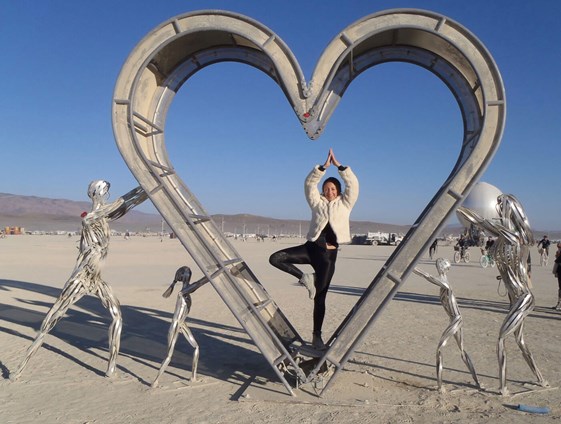
Catherine at Burning Man Festival.
What do you like to do to outside of work and research?
Throughout the lockdowns, cook-alongs, running, hiking and my allotment have been keeping me sane. However, I’m looking forward to getting back to some more adventures travelling, sailing, and skiing again. I got to go to both Glastonbury and Burning Man festivals in 2019 and look forward to attending again post pandemic.

